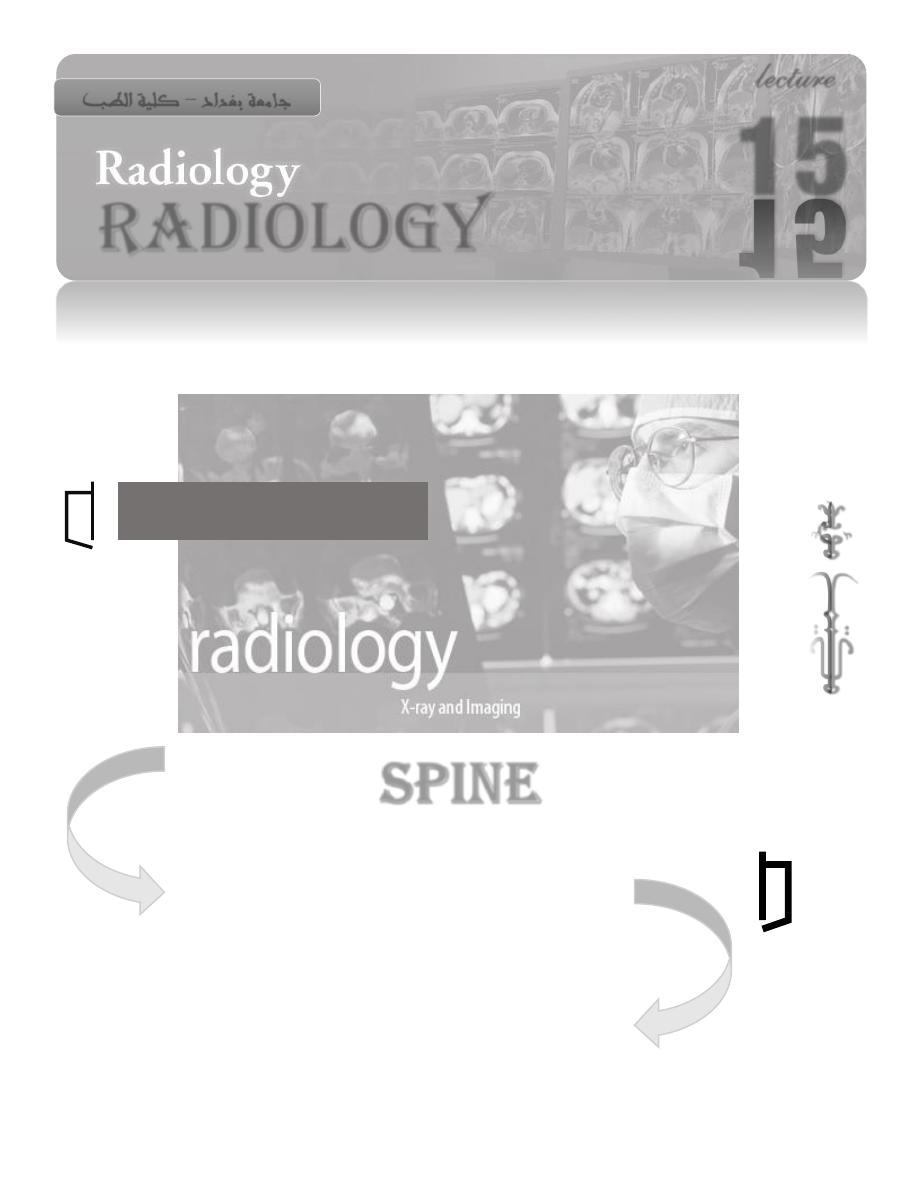
RadioLoGY
lecture
15
جامعة بغداد
–
كلية الطب
SPINE
ؤيد
م بتكم
MUSTAFA laith
Dr Laith


Spine
Radiology 15
Prof Laith
1
Spine
MRI is the imaging modality of choice for detection of spinal
pathology
X ray is still important particularly in spinal trauma.The intervertebral
discs appear radiolucent on X ray
CT is useful in detection of the site of fracture & presence of
intraspinal bone fragment or detection of the presence of foreign
bodies (particularly if metallic )where MRI is contraindicated
Radionuclide bone scan may be used in case of suspected spinal
metastases
On MRI T1 weighted image , the fat within the bone marrow of the
vertebral body appears bright while the CSF & intervertebral discs
appear of low signal .On T2 sequence the CSF & intervertebral disc
appear bright
SIGNS OF ABNORMALITY
Disc space narrowing
1-the discs spaces are normally of the same height at all levels in the
cervical & thoracic spine , in the lumbar spines the disc spaces increase
slightly in height going down the spine except for the disc space at the
lumbosacral junction which is usually narrower than the disc above it
2-MRI on sagittal section clearly shows the height of the disc & any
alteration in the signal intensity suggesting pathology
3- Narrowing of the disc space occurs in degenerative disease & in disc
infection

Spine
Radiology 15
Prof Laith
2
Collapse of the vertebral body
Collapse is loss of height of vertebral body best appreciated on lateral
plain X ray & sagittal MRI section .The causes of collapse are:
a) Metastases & myeloma: bone destruction or replacement of the
normal signal of the bone marrow is well appreciated on MRI. The
pedicle may be destroyed with metastases but the disc space is
usually normal
b) Infection :the disc space is usually narrowed or obliterated , with
destruction of the adjacent bone next to the affescted disc but the
pedicles usually intact .Alteration of the signal intensity of the disc
& the vertebral body due to inflammatory oedema seen on MRI
c) Osteoporosis & osteomalacia: generalized reduction in bone
density , normal or slight increase in the height of the disc space ,
intact pedicles & normal signal intensity of the vertebral body on
MRI
d) Trauma: compression fracture of the vertebral body occurs due to
forward flexion of the spine causing wedging of the vertebral body.
The superior surface is usually concave , the discs are normal or
may be impacted in into the fractured bone, associated fractures of
the pedicle & neural arch may be seen but otherwise the bone &
disc signal intensity are normal
e) Eosinophilic granuloma: complete collapse of one or more of the
vertebral bodies in children or young adults with Langerhan`s
histiocytosis .Flattening of the vertebral body resulting in vertebra
plana. Normal pedicles & adjacent disc spaces seen
Pedicles abnormality
1- On plain film the pedicles are best assessed on the frontal view except
in the cervical spine where the oblique view is necessary
2- Destruction of one or more pedicle is fairly reliable sign of metastases

Spine
Radiology 15
Prof Laith
3
3- Flattening & widening of the distance between the two pedicles
occurs with tumors arising within the spinal canal e.g. meningioma or
neurofibroma
Dense vertebra
1- this sign is seen on X ray & CT
2- single or multiple vertebrae are affected
3- Common causes are :
a) Metastases : from breast or prostate carcinoma
b) Malignant lymphoma
c) Paget`s disease : increase in overall size of the veretbra in this
condition help to make differentiation from metastases , in addition
there is coarse trabeculation
d) Haemangioma : gives characteristic vertical striation in a vertebra
that is of normal size
Lysis within vertebra
1- seen on X ray or CT scan
2- commonest causes
a) Metastases : from bronchus , kidney
b) Multiple myeloma
c) Malignant lymphoma (occasionally )
d) Infection : lysis involve one or two adjacent vertebral bodies &
adjacent disc space is almost invariably narrowed
Paravertebral shadow
1- Easily appreciated on MRI & CT
2- The thoracic spine is the easiest site to recognize such swelling on
plain film as they assume a characteristic fusiform
3- Swelling in the lumbar region have to be very large if they are to
displace the psoas outlines & be recognized on the plain film

Spine
Radiology 15
Prof Laith
4
4- Anterior swelling in the cervical region can be recognized by forward
displacement of the parapharyngeal air shadow
5- Paravertebral soft tissue swelling occur with infection , malignant
neoplasm & hematoma following trauma .Specific diagnostic signs
often present in such cases in the adjacent bones
METASTASES /MYELOMA
MRI is the most accurate test for demonstrating metastases ,
myeloma or lymphoma .The tumor appear hypointense on T1,
hyperintense on T2 with variable enhancement after contrast injection
Metastases are shown as areas of lysis , sclerosis or mixed on plain
film often with involvement of the pedicle .Collapse of one or more
vertebra may occur
Myeloma shown as well defined lytic areas in the vertebral bodies ,
the pedicle is often not involved .Collapse of the vertebra is particular
feature in MM
The intervertebral disc is usually preserved in both metastases & MM
INFECTION
The common infecting organism are M. tuberculosis & S. aureus
The hall mark of the condition is destruction of the intervertebral disc
& adjacent vertebral bodies
Early stage: narrowing of the disc space & erosion of the adjoining
surface of the vertebral bodies
Later bone destruction occurs , sometimes causing collapse with sharp
angulation known as the gibbus
Paravertebral abscess usually present
In Tuberculous spondylitis the lesion is purely lytic with large
paravertebral shadow that may calcify eventually

Spine
Radiology 15
Prof Laith
5
In pyogenic infection bone destruction & sclerosis occur with small
paravertebral shadows
Bony ankylosis (fusion of the vertebral body across the obliterated
disc space ) occurs with healing
CT shows the bone destruction & paravertebral shadows to best
advantage
MRI shows the disc space narrowing alteration in signal intensity of
the spine & presence of paravertebral shadow
FNA or needle biopsy used to identify the infecting organism
SPINAL TRAUMA
Plain film is the initial investigation in trauma to the spine , points to
be assessed are : (a) fracture of the vertebral bodies , pedicles , lamina
& spinous processes (b)alignment of the fractures (c) alignment of the
articular facets & vertebral bodies
The spine is divided in three columns on the lateral view : (1)anterior
column (injuries are considered stable as they do not endanger the
spinal cord ), middle & posterior (unstable injuries )
CT is very helpful in major trauma to the spine as it shows fractures
of the posterior elements, dislocation resulting in unstable spine ,
bone fragments displaced in the spinal canal (burst fracture )that may
need surgical removal .The disadvantage is that CT is inferior to
MRI in showing the state of spinal cord
MRI is excellent in showing the hemorrhage & contusion of the
spinal cord in these patients

Spine
Radiology 15
Prof Laith
6
Degenerative Disc Disease (Spondylosis)
Definition: degeneration of the intervertebral disc .It occurs
maximally in the lower cervical & lower lumbar spines
The degenerate disc may herniated into the surrounding tissue , may
press on the nerve roots or spinal cord resulting in pain &/or
neurological deficit
The degenerate disc stimulate the formation of osteophytes which
together with thickening of the soft tissue may press upon the spinal
cord or nerve roots, the image is further complicated by OA changes
affecting the apophyseal joints
Plain Radiograph in Spondylosis
There is poor correlation between plain radiograph findings & the
severity of symptoms or neurological deficit .The aim of requesting
plain radiograph is to exclude other disease processes
Signs of spondylosis : a)disc space narrowing, b)sclerosis &
osteophytes formation at the adjoining surfaces of the vertebral
bodies .Osteophytes at the posterior aspect of the vertebral body
narrow the spinal canal & may encroach on the exit foramina
resulting in compression of the nerve roots .In the cervical spine the
oblique view is the best to shows osteophytes near the exit foramen
Schmorl`s nodes are indentations into the end plates of the vertebral
bodies due to protrusion of the disc material , these are not part of
disc degeneration & are of no clinical significance

Spine
Radiology 15
Prof Laith
7
MRI In Spondylosis
Degeneration of the disc seen as loss of normal signal intensity on T2
sequence due to dehydration , the disc later lose height & may bulge
Facet joint arthropathy :this is another feature of degenerative spinal
disease .Inflammation of the joint results in joint hypertrophy & may
cause compression of the nerve roots at the exit foramina
Osteophytes pressing on the cord in cervical region can result in
ischemic changes & eventually cord atrophy , this best shown on
sagittal T2 weighted sequence
End plate changes :a)type I : early , low signal on T1 , high signal on
T2 from vascularized fibrous tissue , b)type II : high signal on T1 ,
isointense on T2 from local fatty replacement of the marrow & c)type
III in advanced stage , low SI on both T1 & T2 due to sclerosis
MRI In Disc Herniation
Disc protrusion can vary from small central bulge of little clinical
significance to larger posterolateral or far lateral herniation of disc
material .The herniated disc can migrate a considerable distance &
may become detached from the parent disc (sequestrated disc )
The commonest sites for disc herniation are the three lower cervical
discs & lower lumbar discs
MRI in sagittal section with selective axial sections on the levels of
interest can clearly show the state of disc & spinal cord
One third of demonstrable disc herniation is asymptomatic , therefore
the criteria for surgery should be clear cut evidence of compression
of the clinically affected nerve root
Cervical disc herniation can press on the nerve root sheath or may
compress the spinal cord .These changes can be aggravated by
hypertrophy of the spinal ligaments , facet joint arthritis &
osteophytes formation

Spine
Radiology 15
Prof Laith
8
Lumbar disc herniation occurs most commonly at the levels L4-5,
L5-S1.They are directly visualized as small focal projections that
points towards the neural foramen .Loss of visualization of the fat
surrounding the nerve root sheath is helpful indication of nerve root
compression
MRI is useful for patients who continued to have symptoms after
surgery for disc herniation .Post operative scarring shows higher
signal in comparison to recurrent disc & shows enhancement after
contrast in contrast to recurrent disc
CT In Disc Herniation
CT for disc herniation has been largely replaced by MRI
On CT the disc is of lower density than the adjacent bone , the
content of the dural sac are all of the same density .The nerve root
sheath are seen as circular dots adjacent to the dural sac surrounded
by fat within the spinal canal
Spinal Stenosis
congenital spinal stenosis can give rise to cord or nerve roots
compression especially when spondylotic changes supervene
MRI is the ideal method to show the shape & size of the spine
Ankylosing Spondylitis
The sacroiliac joints & the spine are principally affected
Sacroiliac joints involvement precede the spine
The earliest radiological sign is fuzziness of the SI joint margin
which progress to frank erosion & later obliteration of the joint space

Spine
Radiology 15
Prof Laith
9
The spinal ligaments ossify forming vertically oriented bony bridges
between the vertebral bodied .The apophyseal joints &
costotransverse joints become fused .In advance stage the whole
spine becomes a solid block of bone forming what is called bamboo
spine
Spina Bifida
Incomplete closure of the vertebra canal usually in the lumbosascral
region , may be associated with protrusion of the spinal cord
(meningomyelocele ) or its membranes (meningocele).
There is absent of the lamina of several vertebra with increased
interpedicular distance
CT& MRI are useful to verify the condition & to assess any
associated abnormalities
US can provide antenatal diagnosis
Spina bifida occulta is a condition in which no external abnormality is
present & no neurological deficit but failure of the two laminae to
fuse , this occur at any level commonly the lumbosacral region
Spondylolisthesis
Definition : forward slipping of the one vertebral body over the one
below it , occurring most commonly at the lumbosacral junction &
between L4 & L5 vertebral bodies
Cause : defect at the pars interarticularis (junction of the superior &
inferior articular facet of the same vertebra ) secondary to stress
fracture
Minor slipping can occur without defect in the pars interarticularis if
there is degenerative disc disease with osteoarthritis of the
apophyseal joints
Oblique & lateral views are used to visualize the defect

Spine
Radiology 15
Prof Laith
10
Radionuclide scanning shows increase uptake at the site of defect
before X ray abnormality is seen
Spondylolysis : defect of the pars interarticularis without slipping
Spinal Cord Compression
MRI is the modality of choice to show the cause, level & extent of spinal
cord compression
Causes :
1. extradural lesions : metastases , spinal tuberculosis , cervical
disc herniation (lumbar discs are too low to compress the
spinal cord ), bone & soft tissue reactions that accompany
spondylosis
2. intradural extramedullary lesions i.e. lesions within the dura
but outside the spinal cord as neurofibroma or meningioma
3. intramedullary lesions as spinal cord tumors or hemorrhage
into the spinal cord
Intrinsic Disorders of the Spinal Cord
MRI is excellent in demonstrating conditions that expand the cord e.g.
syringomyelia , hematoma , tumors or those condition that do not cause
expansion as demyelination plaque of multiple sclerosis
Contrast enhanced MRI is required in multiple sclerosis to assess the
activity of the disease as enhancement indicates currently active
disease
End of Lecture 15
